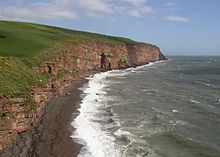Bromsgrove Sandstone Formation
| Sherwood Sandstone Group Stratigraphic range: Triassic |
|
|---|---|

St Bees Sandstone, St Bees South Head, Cumbria
|
|
| Type | Group |
| Unit of | New Red Sandstone Supergroup |
| Sub-units | Bromsgrove Sandstone, Wildmoor Sandstone, Kidderminster, Chester Pebble Beds, Kinnerton Sandstone, Tarporley Siltstone, Helsby Sandstone, Upper Mottled Sandstone and Lower Mottled Sandstone Formations |
| Underlies | Mercia Mudstone Group |
| Overlies | Roxby Formation and others |
| Thickness | over 1500m |
| Lithology | |
| Primary | sandstone |
| Other | mudstone, siltstone, conglomerate |
| Location | |
| Country | England |
| Extent | widespread |
| Type section | |
| Named for | Sherwood Forest |
The Sherwood Sandstone Group is a Triassic lithostratigraphic group (a sequence of rock strata) which is widespread in Britain, especially in the English Midlands. The name is derived from Sherwood Forest in Nottinghamshire which is underlain by rocks of this age. It has economic importance as the reservoir of the Morecambe Bay gas field, the second largest gas field in the UK.
These rocks are found in northwest England as far north as Carlisle (and extending just into Scotland around Annan and Gretna) and in the Vale of Eden and then extending down the Cumbrian coast into Lancashire and Cheshire. They are mostly obscured by superficial deposits but the highest coastal cliffs in northwest England at St Bees Head are formed in the St Bees Sandstone, the lowermost formation within the group.
In the northeast they extend from Hartlepool south through the Vale of Mowbray and the Vale of York, then south through Nottinghamshire into the English Midlands, though are very largely concealed by superficial sediments. They occur widely through the Midlands (though usually concealed) and notably in an outlier at Leek, Staffordshire. They extend south to the Severn Estuary and beyond there through Somerset to Budleigh Salterton on the coast of East Devon.
...
Wikipedia
